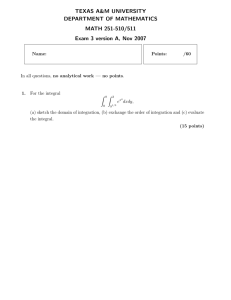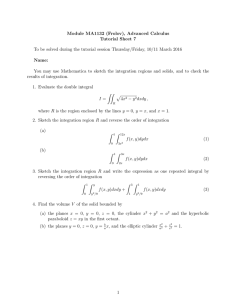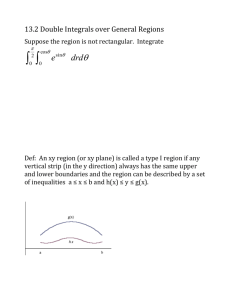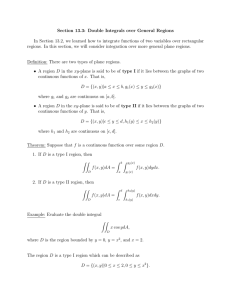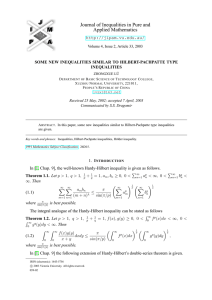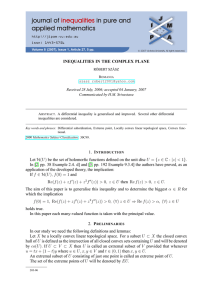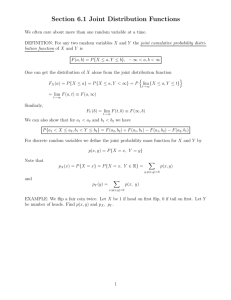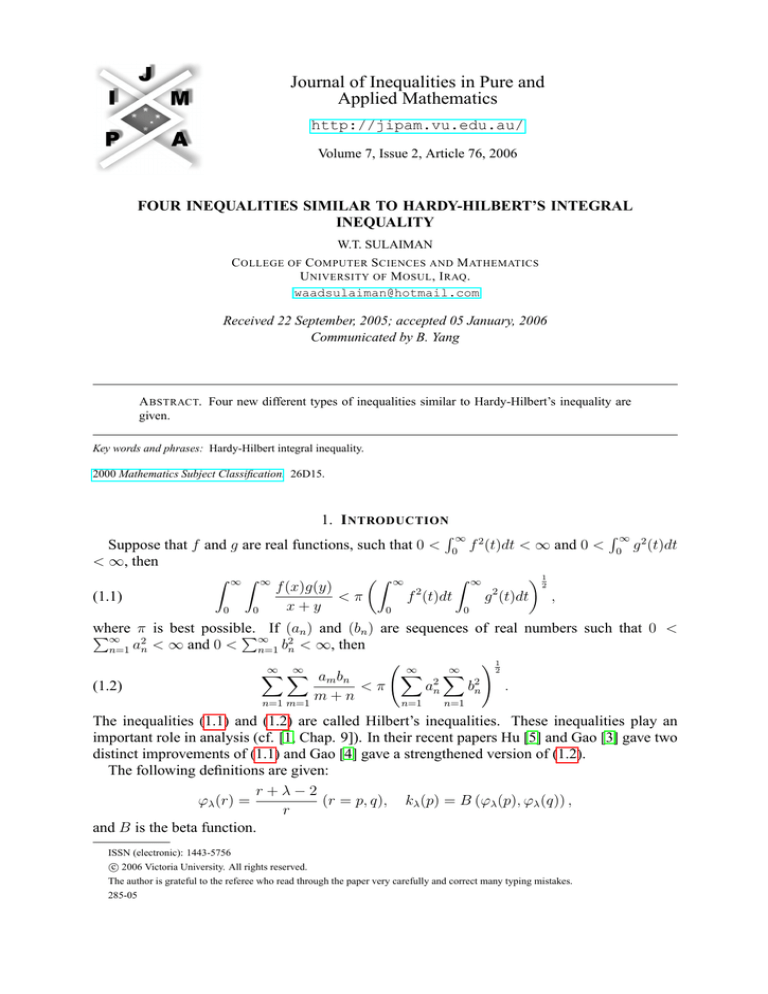
Journal of Inequalities in Pure and
Applied Mathematics
http://jipam.vu.edu.au/
Volume 7, Issue 2, Article 76, 2006
FOUR INEQUALITIES SIMILAR TO HARDY-HILBERT’S INTEGRAL
INEQUALITY
W.T. SULAIMAN
C OLLEGE OF C OMPUTER S CIENCES AND M ATHEMATICS
U NIVERSITY OF M OSUL , I RAQ .
waadsulaiman@hotmail.com
Received 22 September, 2005; accepted 05 January, 2006
Communicated by B. Yang
A BSTRACT. Four new different types of inequalities similar to Hardy-Hilbert’s inequality are
given.
Key words and phrases: Hardy-Hilbert integral inequality.
2000 Mathematics Subject Classification. 26D15.
1. I NTRODUCTION
R∞
R∞
Suppose that f and g are real functions, such that 0 < 0 f 2 (t)dt < ∞ and 0 < 0 g 2 (t)dt
< ∞, then
Z ∞
12
Z ∞Z ∞
Z ∞
f (x)g(y)
2
2
(1.1)
<π
f (t)dt
g (t)dt ,
x+y
0
0
0
0
where
n ) and (bn ) are sequences of real numbers such that 0 <
P∞ π2 is best possible.
P∞If (a
2
n=1 an < ∞ and 0 <
n=1 bn < ∞, then
! 12
∞ X
∞
∞
∞
X
X
X
am b n
(1.2)
<π
a2n
b2n
.
m+n
n=1 m=1
n=1
n=1
The inequalities (1.1) and (1.2) are called Hilbert’s inequalities. These inequalities play an
important role in analysis (cf. [1, Chap. 9]). In their recent papers Hu [5] and Gao [3] gave two
distinct improvements of (1.1) and Gao [4] gave a strengthened version of (1.2).
The following definitions are given:
r+λ−2
ϕλ (r) =
(r = p, q), kλ (p) = B (ϕλ (p), ϕλ (q)) ,
r
and B is the beta function.
ISSN (electronic): 1443-5756
c 2006 Victoria University. All rights reserved.
The author is grateful to the referee who read through the paper very carefully and correct many typing mistakes.
285-05
2
W.T. S ULAIMAN
Recently, by introducing some parameters, Yang and Debnath [2] gave the following extensions:
Theorem A. If f, g ≥ 0, p > 1, p1 + 1q = 1, λ > 2 − min {p, q} , such that
Z ∞
Z ∞
1−λ p
0<
t f (t)dt < ∞ and 0 <
t1−λ g q (t)dt < ∞,
0
0
then
∞
Z
∞
Z
(1.3)
0
f (x)g(y)
(Ax + By)λ
0
dxdy
∞
Z
kλ (p)
< ϕ (p) ϕ (q)
A λ B λ
x
1−λ p
p1 Z
∞
y
f (x)dx
1−λ q
g (y)dy
1q
,
0
0
where the constant factor [kλ (p)/Aϕλ (p) B ϕλ (q) ] is the best possible.
Theorem B. If f ≥ 0, p > 1,
R ∞ 1−λ p
t f (t)dt < ∞, then
0
Z
∞
y
(1.4)
(λ−1)(p−1)
Z
0
∞
1
p
+
1
q
= 1, λ > 2 − min {p, q} , A, B > 0 such that 0 <
!p
f (x)
dx
(Ax + By)λ
0
dy <
kλ (p)
ϕ
λ
A (p) B ϕλ (q)
p Z
∞
x1−λ f p (x)dx,
0
p
where the constant factor kλ (p)/Aϕλ (p) B ϕλ (q) is the best possible. The inequalities (1.3) and
(1.4) are equivalent.
Theorem C. If an , bn > 0 (n ∈ N), p > 1, p1 + 1q = 1, 2 − min {p, q} < λ < 2, A, B > 0 such
that
∞
∞
X
X
1−λ p
0<
n an < ∞ and 0 <
n1−λ bqn < ∞,
n=1
n=1
then
! p1 ∞
! 1q
∞
X
X
kλ (p)
(1.5)
< ϕ (p) ϕ (q)
n1−λ apn
n1−λ bqn
,
λ
λ
λ
A
B
(Am
+
Bn)
n=1 m=1
n=1
n=1
where the constant factor kλ (p)/Aϕλ (p) B ϕλ (q) is the best possible.
∞ X
∞
X
am b n
Theorem D. If an ≥ 0 (n ∈ N), p > 1, p1 +
P
1−λ p
that 0 < ∞
an < ∞, then
n=1 n
(1.6)
∞
X
n=1
n
(λ−1)(p−1)
∞
X
1
q
!p
am
λ
m=1
= 1, 2 − min {p, q} < λ ≤ 2, A, B > 0 such
(Am + Bn)
<
kλ (p)
ϕ
A λ (p) B ϕλ (q)
p X
∞
n1−λ apn ,
n=1
p
where the constant factor kλ (p)/Aϕλ (p) B ϕλ (q) is the best possible. The inequalities (1.5) and
(1.6) are equivalent.
2. N EW I NEQUALITIES
The aim of this paper is to give the following results:
J. Inequal. Pure and Appl. Math., 7(2) Art. 76, 2006
http://jipam.vu.edu.au/
F OUR I NEQUALITIES S IMILAR T O H ARDY-H ILBERT ’ S I NTEGRAL I NEQUALITY
3
Theorem 2.1. Let ln f , ln g be convex for nonnegative functions f and g such that f (0) =
g(0) = 0, f (∞) = g(∞) = ∞, f 0 (s) ≥ 0, g 0 (s) ≥ 0, s ∈ {xp , y q } . Let λ > max {p, q} ,
p > 1, p1 + 1q = 1. Let
Z ∞ −p2 /q2
Z ∞ −q2 /p2
[f (tp )]2−λ+p/q
t
t
[g(tq )]2−λ+q/p
0<
dt < ∞, 0 <
dt < ∞,
p
q
[f 0 (t)] q
[g 0 (t)] p
0
0
then we have
Z ∞Z ∞
f (xy)g(xy)
dxdy
(2.1)
(f (xp ) + g(y q ))λ
0
0
1
1
1
p (p, λ − p) B q (q, λ − q)
≤ √
B
√
p p q q
! p1 Z
! 1q
Z ∞ −p2 /q2
∞ −q 2 /p2
t
[f (tp )]2−λ+p/q
t
[g(tq )]2−λ+q/p
×
dt
dt
.
p
q
[f 0 (t)] q
[g 0 (t)] p
0
0
xp
p
p
Proof. Since ln f is convex and xy ≤
ln f
x
p
f (xy) = eln f (xy) ≤ e
Therefore, we have
Z ∞Z ∞
f (xy)g(xy)
0
0
(f (xp ) + g(y q ))λ
∞
yq
,
q
q
+ yq
then
ln f (xp )
ln f (y q )
+
p
q
≤e
0
1
f p (xp )g q (y q ) [g (y
1
q )] p
q−1
p
p−1
x q
1
∞
Z
∞
≤
0
×
λ
q
1
dxdy
f (xp )g p/q (y q )g 0 (y q )y q−1
0
= M pN q,
p−1
q
q−1
y p
x
(f (xp ) + g(y q )) q
! p1
dxdy
p
x(p−1)p/q [f 0 (xp )] q (f (xp ) + g(y q ))λ
Z ∞Z ∞
f (y q )g q/p (xp )f 0 (xp )xp−1
0
1
1
p )] q
1
[g 0 (y q )] p
λ
Z
0
1
(f (xp ) + g(y q )) p
0
1
f q (y q )g p (xp ) [f (x
y
1
[f 0 (xp )] q
≤
0
1
= f p (xp )f q (y q ).
dxdy
1
∞Z
Z
+
0
! 1q
y (q−1)q/p [g 0 (y q )] p (f (xp ) + g(y q ))λ
dxdy
say.
Then
1
M=
q
Z
1
=
q
Z
∞
2−λ+p/q
x(1−p)p/q [f (xp )]
dx
p
[f 0 (x)] q
0
∞
2 /q 2
x−p
∞
Z
g(y q )
f (xp )
0
[f (xp )]2−λ+p/q
Z
∞
pq
1+
q−1
g 0 (y q ) qy
f (xp )
dy
λ
q
g(y )
f (xp )
up/q
dx
du
p
(1 + u)λ
[f 0 (x)] q
0
Z ∞ −p2 /q2
1
x
[f (xp )]2−λ+p/q
= B (p, λ − p)
dx.
p
q
[f 0 (x)] q
0
0
Similarly,
1
N = B (q, λ − q)
p
J. Inequal. Pure and Appl. Math., 7(2) Art. 76, 2006
Z
∞
y −q
2 /p2
[g(y q )]2−λ+q/p
q
0
[g 0 (y)] p
dy.
http://jipam.vu.edu.au/
4
W.T. S ULAIMAN
Therefore
Z ∞Z ∞
0
f (xy)g(xy)
dxdy
(f (xp ) + g(y q ))λ
1
1
1
p (p, λ − p) B q (q, λ − q)
≤ √
B
√
q p p q
! p1
Z ∞ −p2 /q2
p 2−λ+p/q
t
[f (t )]
×
t
dt
p
[f 0 (t)] q
0
0
Z
∞ −q 2 /p2
t
q
2−λ+q/p
[g(t )]
q
0
[g 0 (t)] p
! 1q
dt
.
Theorem 2.2. Let f, g, h be nonnegative functions, h(x, y) is homogeneous of order n such that
h(0, 1) = h(1, 0) = 0, h(∞, 1) = h(1, ∞) = ∞. Let p > 1, p1 + 1q = 1,
n
o
0 < 1 + µ − r < λ, r ∈ pq , pq , hx (x, y) ≥ 0, hy (x, y) ≥ 0,
where hx = dh/dx, 0 <
Z
(2.2)
0
∞
Z
∞
R∞
tp/q f p (t)dt < ∞, 0 <
0
R∞
0
tq/p g q (t)dt < ∞, then
f (x)g(y)hµ (x, y)
dxdy
(1 + h(x, y))λ
1
p
q
p
q
1 p1
q
B
≤ B
1 + µ− , λ − 1 − µ+
1 + µ− , λ − 1 − µ−
n
q
q
p
p
Z ∞
p1 Z ∞
1q
p
q
p
q
q−1
p−1
×
t f (t)dt
t g (t)dt .
0
0
Proof. Observe that
Z ∞Z
0
∞
0
f (x)g(y)hµ (x, y)
dxdy
(1 + h(x, y))λ
! p1
Z ∞Z ∞ p
f (x)hµ (x, y)hy (x, y)
≤
dxdy
p/q
hx (x, y) (1 + h(x, y))λ
0
0
! 1q
Z ∞Z ∞ q
g (y)hµ (x, y)hx (x, y)
×
dxdy
q/p
hy (x, y) (1 + h(x, y))λ
0
0
0
1
1
= M pN q,
say.
Then
Z
M=
∞
p
Z
f (x)dx
0
0
∞
hµ (x, y)hy (x, y)
p/q
hx (x, y) (1 + h(x, y))λ
dy.
Let y = xv, dy = xdv and hence
dh(x, xv)
dh(1, v)
dh(1, v)
= xn
= xn−1
= xn−1 hv (1, v),
dy
dy
dv
dh(x, xv)
d n
hx (x, y) =
=
x h(1, v) = nxn−1 h(1, v),
dx
dx
hy (x, y) =
J. Inequal. Pure and Appl. Math., 7(2) Art. 76, 2006
http://jipam.vu.edu.au/
F OUR I NEQUALITIES S IMILAR T O H ARDY-H ILBERT ’ S I NTEGRAL I NEQUALITY
5
therefore
M=
1
∞
Z
x
Z
p/q−1 p
∞
f (x)dx
[xn h(1, v)]µ−p/q xn hv (1, v)
(1 + xn h(1, v))λ
Z ∞
1
p
p
= p/q B 1 + µ− , λ − 1 − µ+
xp/q−1 f p (x)dx.
n
q
q
0
np/q
0
dv
0
Similarly,
1
q
q
N = q/p B 1 + µ − , λ − 1 − µ +
n
p
p
Z
∞
y q/p−1 g q (y)dy.
0
This implies
Z ∞Z ∞
f (x)g(y)hµ (x, y)
0
0
dxdy
(1 + h(x, y))λ
1
1 p1
p
p
q
q
≤ B
1 + µ − , λ − 1 − µ+
B q 1 + µ − , λ − 1 − µ+
n
q
q
p
p
Z ∞
p1 Z ∞
1q
p/q−1 p
q/p−1 q
×
t
f (t)dt
t
g (t)dt .
0
0
The following lemma is needed for the coming result.
Lemma 2.3. Let s ≥ 1, 0 < 1 + µ ≤ min {α, λ} and define
Z s
tµ
−α
f (s) = s
dt,
λ
0 (1 + t)
then f (s) ≤ f (1).
Proof. We have
0
f (s) = s
≤
sµ
−α
Z
λ
(1 + s)
s
µ−α
+
s
tµ
λ
dt (−α) s−α−1
0 (1 + t)
−α−1 Z s
αs
tµ dt
(1 + s)λ 0
−
(1 + s)λ
α
sµ−α
1−
=
≤ 0.
1+µ
(1 + s)λ
This shows that f is nonincreasing and hence f (s) ≤ f (1).
Rs
Theorem 2.4. Let f, g, F, G be nonnegative functions such that Fn(s) =
o
Rs
p q
1
1
+
=
1,
(1
−
λ/2)r
≤
λ/2
+
α
≤
2α,
r
∈
,
,
g(t)dt,
let,
p
>
1,
p
q
q p
0
Z
f (t)dt, G(s) =
x
0<
Z0 x
0<
0
(x − t)t(1−λ/2)p/q−λ/2−α F p−1 (t)f (t)dt < ∞,
(x − t)t(1−λ/2)q/p−λ/2−α Gq−1 (t)g(t)dt < ∞,
0
J. Inequal. Pure and Appl. Math., 7(2) Art. 76, 2006
http://jipam.vu.edu.au/
6
W.T. S ULAIMAN
then
Z
x
x
Z
F (s)G(t)
dsdt
(s + t)λ
Z x
p1
√
√
p p q q
≤
xα B λ2 , λ2
(x − t)t(1−λ/2)p/q−λ/2−α F p−1 (t)f (t)dt
2
0
Z x
1q
(1−λ/2)q/p−λ/2−α q−1
×
(x − t)t
G (t)g(t)dt .
(2.3)
0
0
0
Proof. Observe that
Z xZ x
F (s)G(t)
0
0
(s + t)λ
x
Z
dsdt
F (s)
x
Z
=
0
x
x
Z
≤
0
1
t1/p
s1/q
λ/2−1
G(t)
·
(s + t)λ/p
0
Z
F p (s)tλ/2−1
1
= M pN q,
s1/q
t1/p
λ/2−1
dsdt
(s + t)λ/q
! p1 Z
(s + t)λ s(λ/2−1)p/q
0
x
Z
x
dsdt
0
0
Gq (t)sλ/2−1
(s + t)λ t(λ/2−1)q/p
! 1q
dsdt
say.
Then
x
Z
M=
s
(1−λ/2)p/q−λ/2
F (s)ds
0
0
x
Z
=
s
(1−λ/2)p/q−λ/2
p
F (s)ds
0
Z
x
Z
p
x
≤
s
0
α
x
=
B
2
(1−λ/2)p/q−λ/2
λ λ
,
2 2
Z
p
F (s)ds
t λ/2−1 1
s
s
t λ
1+ s
dt
x α x −α Z
s
s
x α Z
s
0
1
x/s
0
uλ/2−1
(1 + u)λ
uλ/2−1
(1 + u)λ
du
du
x
s(1−λ/2)p/q−λ/2−α F p (s)ds,
0
by virtue of the lemma.
As
Z
p
F (s) = p
s
F p−1 (u)f (u)du,
0
then
Z x
Z s
p α
λ λ
(1−λ/2)p/q−λ/2−α
M= x B
,
s
ds
F p−1 (u)f (u)du
2
2 2
0
Z0 x Z s
p α
λ λ
= x B
,
u(1−λ/2)p/q−λ/2−α F p−1 (u)f (u)dsdu
2
2 2
Z0 x 0
p
λ λ
= xα B
,
(x − s)s(1−λ/2)p/q−λ/2−α F p−1 (s)f (s)ds.
2
2 2
0
Similarly,
q
N = xα B
2
λ λ
,
2 2
Z
J. Inequal. Pure and Appl. Math., 7(2) Art. 76, 2006
x
(x − t)t(1−λ/2)q/p−λ/2−α Gq−1 (t)g(t)dt.
0
http://jipam.vu.edu.au/
F OUR I NEQUALITIES S IMILAR T O H ARDY-H ILBERT ’ S I NTEGRAL I NEQUALITY
7
Therefore, we have
Z
0
x
x
Z
F (s)G(t)
dsdt
(s + t)λ
Z x
p1
√
√
p p q q
λ λ
α
(1−λ/2)p/q−λ/2−α p−1
≤
x B
,
(x − t)t
F (t)f (t)dt
2
2 2
0
Z x
1q
(1−λ/2)q/p−λ/2−α q−1
×
(x − t)t
G (t)g(t)dt .
0
0
Theorem 2.5. Let f, g be nonnegative functions, f is submultiplicative and g is concave nonincreasing, f 0 (x), g 0 (y) ≥ 0, f (0) = g(0) = 0, f (∞) = g(∞) = ∞, p > 1, p1 + 1q = 1,
0 < a + 1 < λ, 0 < b + 1 < λ,
Z ∞
Z ∞
[f (x)]µp−bp/q [g(x)]1+a−λ
[g(y)]µq−aq/p [f (y)]1+b−λ
0<
dx
<
∞,
0
<
dy < ∞,
p
q
[f 0 (x)] q
[g 0 (y)] p
0
0
then
∞
Z
∞
Z
(2.4)
0
0
Proof. Since
1
1
f µ (xy)
dxdy ≤ 2λ/2 B p (a + 1, λ − a − 1) B q (b + 1, λ − b − 1)
λ/2
g (xy)
! p1 Z
! 1q
Z ∞
∞
[f (t)]µp [g(t)]1+a−λ−bp/q
[f (t)]µq [g(t)]1+b−λ−aq/p
×
dt
dt
.
p
q
[g 0 (t)] q
[g 0 (t)] p
0
0
√
xy ≤
x+y
,
2
then
2 2
√
x+y
g(x) + g(y)
√
2
2
≥
,
g(xy) = g ( xy) ≥ (g ( xy)) ≥ g
2
2
and hence
Z
0
∞
Z
0
∞
f µ (xy)
dxdy
g λ/2 (xy)
Z ∞Z
λ/2
≤2
0
∞
f µ (x)f µ (y)
(g(x) + g(y))λ
0
a/p
= 2λ/2
∞
Z
∞
1/p
0
[g (y)]
f µ (x) [g(y)]
[g(x)]b/q [g 0 (x)]1/q
λ
b/q
·
[g(x)]
f µ (y) [g(y)]
a/p ·
[g 0 (x)]1/q
[g 0 (y)]1/p
λ
(g(x) + g(y)) q
! p1
Z ∞Z ∞
f µp (x)g a (y)g 0 (y)
dxdy
p
[g(x)]bp/q [g 0 (x)] q (g(x) + g(y))λ
0
0
! 1q
Z ∞Z ∞
f µq (y)g b (x)g 0 (x)
×
dxdy
q
[g(y)]aq/p [g 0 (y)] p (g(x) + g(y))λ
0
0
0
≤ 2λ/2
Z
dxdy
0
1
1
= 2λ/2 M p N q ,
J. Inequal. Pure and Appl. Math., 7(2) Art. 76, 2006
(g(x) + g(y)) p
say.
http://jipam.vu.edu.au/
8
W.T. S ULAIMAN
Then
Z
∞
M=
µp
1+a−λ−bp/q
[f (x)] [g(x)]
dx
p
0
∞
Z
[g 0 (x)] q
0
∞
Z
= B (a + 1, λ − a − 1)
g(y)
g(x)
a
1+
g 0 (y)
g(x)
g(y)
g(x)
λ dy
[f (x)]ηp [g(x)]1+a−λ−bp/q
p
[g 0 (x)] q
0
dx.
Similarly, we can show that
Z
N = B (b + 1, λ − b − 1)
∞
[f (y)]µq [g(y)]1+b−λ−aq/p
q
0
[g 0 (y)] p
dy.
The result follows.
R EFERENCES
[1] G.H. HARDY, J.E. LITTLEWOOD
bridge, 1952.
AND
G. POLYA, Inequalities, Cambridge Univ. Press. Cam-
[2] B. YANG AND L. DEBNATH, On the extended Hardy-Hilbert’s inequality, J. Math. Anal. Appl.,
272 (2002), 187–199.
[3] M. GAO, TAN LI AND L. DEBNATH, Some improvements on Hilbert’s integral inequality, J. Math.
Anal. Appl., 229 (1999), 682–689.
[4] M. GAO, A note on Hilbert double series theorem, Hunan Ann. Math., 12(1-2) (1992), 142–147.
[5] HU KE, On Hilbert’s inequality, Chinese Ann. of Math., 13B(1) (1992), 35–39.
[6] W. RUDIN, Principles of Mathematical Analysis, Third Edition, McGraw-Hill Book Co. 1976.
J. Inequal. Pure and Appl. Math., 7(2) Art. 76, 2006
http://jipam.vu.edu.au/

